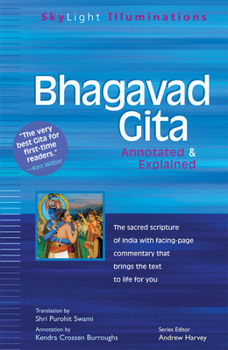Bhagavad Gita: Annotated & Explained
Select Format
Select Condition 
Book Overview
A Hindu classic with universal appeal for people of all faith traditions who turn to its inspirational support in the struggles of life, its consolation in times of grief and its deeply moving promise of God's love and guidance.
Format:Paperback
Language:English
ISBN:1893361284
ISBN13:9781893361287
Release Date:May 2001
Publisher:Skylight Paths Publishing
Length:192 Pages
Weight:0.60 lbs.
Dimensions:0.6" x 5.5" x 8.5"
Customer Reviews
2 ratings
recent Gita effort is the best available
Published by Thriftbooks.com User , 19 years ago
Kendra Crossen Burroughs has done a great service with the annotations of Sri Purohit Swami's classic translation of Bhagavad Gita, the Topmost Hindu Sacred Text. Not only is the translation unrivaled in its ability to communicate the universal message of God to humanity,but it is a joy to read and study thanks to clear English and an ability to prune down the additives of the original to a bare minimum. I was also thrilled to see that the annotations selected leaned heavily toward the recorded words of many of the primary exponents of Vedantic and Vaishnava philosophy in the West. The combination of crisp text and exquisite annotations makes this translation a must for all students of the Song of God. One only wishes that it was available as a hardcover. I know my copy will be used often and consulted any time i use another translation for whatever reason.
A Gita for Everyone
Published by Thriftbooks.com User , 22 years ago
In my experience Kendra Crossen Burroughs is one of the best editors in the field of Eastern spiritual literature and texts. As well as working freelance, she has been a long-term editor on the staff of Shambhala Publications, and I was happy to have her involved in a book that I had published by Shambhala, although not a book in Eastern thought.I was very excited when I heard that Kendra was doing this book for Skylight Paths, since the Gita has been one of my, and many other people's favorite and most important spiritual sources, and I eagerly looked forward to its appearance. If I wasn't one of the first people in the world to buy a copy, at least I was one of the first on my block.I was not disappointed. If I was, I would have never written this review. A blurb on the cover by renowned authority, Ken Wilber, says, "The very best Gita for first time readers." This is one of the rare occasions when a blurb is absolutely true. But, the further truth is that Burroughs's annotations make this a book for the experienced reader of the Gita as well. Burroughs has consulted and used over twenty other translations in her annotations to this particular translation that she uses, the 1935 one by Shri Purohit Swami, and this scholarship, plus Burroughs' own personal experience, make this a valuable book for a reader of any degree of experience.Besides Burroughs' own brilliant annotations, Skylight has done an innovative and equally brilliant job of format, where the annotations are on one page, and the reference text is on the facing page, so that the reader has the annotations right at hand as s/he reads, and does not have to thumb through to the back of the book or chapter to look them up. The only problem that I encountered with this was my own idiosyncratic one of whether to read the text page through and then turn to the annotations alongside it, or read each annotation as it is referred to in the text. I never completely settled this for myself. Other readers may want to read the annotation page first, and then read the facing page of the Gita text.As Burroughs notes, the Purohit translation is a good first time one, because he purposely set out to eliminate all foreign words of the Indian Sanskrit language, and uses only terms familiar to the Western, English speaking reader. For myself, however, who is not a newcomer to Eastern thought (though certainly not a Gita scholar at all), I am less happy with this choice. I want to know what the key Sanskrit terms are in the Gita text, which have a meaning and connotation that is at least somewhat different than the familiar English terms used. For example, in the famous and central verses (Ch 4: 7-8) where Krishna tells his disciple Arjuna about who he is and the reason for his periodic appearance in human history, the Purohit text has it, "To protect the righteous, to destroy the wicked, and to establish the kingdom of God, I am reborn from age to age." The very Christian phrase "the kingdom of God," co






